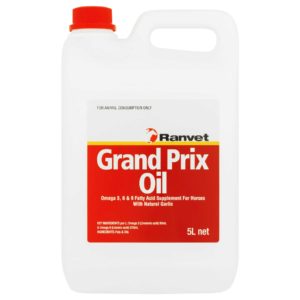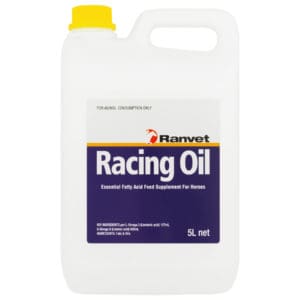Feeding fat in the horses diet
Fats are a beneficial inclusion to a ration, as they increase the energy density of the ration via a ‘cool’ form of energy, improve coat quality, prolong the onset of muscle fatigue and reduce the dry matter intake in warmer climates where horses typically experience a reduction in appetite. While most oils contain a similar energy value of approximately 2.25 times that of cereal grains, quality is defined by the balance of Omega-3 (Linolenic) and Omega-6 (Linoleic) fatty acids.
Benefits to feeding fats in a horse’s diet:
- Concentrated energy source. They provide 2.25 times more energy on digestion than carbohydrates or protein. Small amounts can boost the energy density of a ration requiring less bulk to be fed.
- Increased energy utilisation. Oils have a digestibility ranging from 76-94%. Exercising horses require less total energy when fat is aerobically digested during extended exercise.
- Higher glycogen levels and slower depletion of muscle glycogen. Studies have shown that heart rates were slower to increase during medium intensity exercise and galloping horses were able to work harder and longer when 10% fat was substituted for grain energy. During extended exercise, aerobic metabolism of fatty acids can delay blood glucose and glycogen depletion, resulting in higher muscle reserves being retained at the end of exercise and lower lactic acid accumulation and slow the onset of fatigue.
- Reduction in gut fill.
- Supply of metabolic water during metabolism. Fats provide almost double the amount of metabolic water during aerobic metabolism compared to carbohydrates and protein making fats useful for horses performing for extended times by partly counteracting fluid loss from the cells and blood.
- Skin health and coat. Supplementation of omega fatty acids can provide a noticeable increase in coat quality for horses with poor coat quality.
- Reduced dust in feed. Adding 1-2% of oil to a mixed feed will help reduce dust and risk of airway allergy from inhaled dust as a horse eats.
Omega-3, 6 & 9 Explained:
Each oil or fat has a blend of different fatty acids in its triglyceride content. Omega-3 fatty acids have the first double bond in their structure at the third carbon position and Omega-6 at the sixth carbon position. Monounsaturated fatty acids have the first double bond at the ninth carbon position in the chain. The omega position of a fatty acid cannot be converted from one to another in an animal’s body.
- Oils that contain higher amounts of Omega-3 fatty acids are considered to provide natural anti-inflammatory compounds (called eicosanoids) and hormone action to improve the function and strength of blood vessels and body cells
- Omega-6 fatty acids in high intakes impart hormone induced inflammatory activity, which can interfere with cell metabolism. They contain more linoleic acid which has a coat conditioning effect.
- The monounsaturated Omega-9 fatty acids help to lessen the harmful effects of the other polyunsaturated fatty acids during metabolism.
While all oils contain the same energy level of 33MJ, quality is defined by the balance of Omega-3 (Linolenic) and Omega-6 (Linoleic) fatty acids. High intakes of Omega-3 or Omega-6 fatty acids can imbalance the controlling action of other fatty acids.
In animals, an Omega-3 to Omega-6 fatty acid ratio of:
1 part Omega-3 : 5-10 parts Omega-6 is considered beneficial
When providing an oil to your horse, it is important to consider the Omega-3 to Omega-6 ratio to maximise utilisation. Ranvet’s Grand Prix Oil and Racing Oil are specifically formulated oils for the performance and racing horse. The use of 30-250mL/day of Ranvet’s Grand Prix Oil or Racing Oil which contains an appropriate blend of Omega-3 and Omega-6 fatty acids will provide the ‘cool’ energy and coat shine a performance horse needs.
Important Feeding Notes:
- Introduce oil slowly, we suggest 40 mL increments at 3-4 day intervals.
- Do not aerate the oil by shaking the containing prior to use.
- Store oil in cool place.


Experts in Equine Nutrition
Every product in the Ranvet range has been developed to meet a horse’s most specific need at any given time, be it in a training environment or on a breeding farm. Having pioneered the formulation of specific medications and dietary supplements for horses, the company is now recognised as a leader in the areas of equine health and nutrition.
